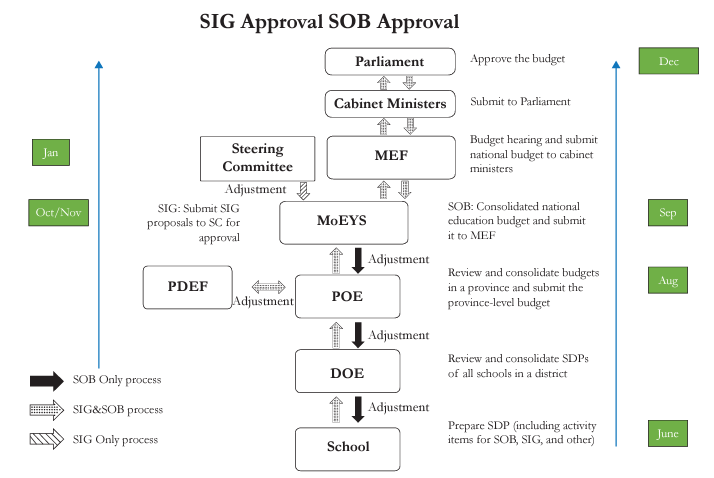The Implementation Plan for the Social Accountability Framework (I-SAF) aims to empower local citizens, enhance local authorities’ accountability and improve the relationship between local service providers and citizens. 1The project is implemented under four main components:
- access to information and open budgets
- citizen monitoring
- facilitation and capacity building
- learning and operating. 2
These four components are the key to ensure greater decentralization, social accountability and transparency within public services.3 Partnering with relevant ministries, civil societies, local authorities and many development partners, the National Committee for Sub-National Democratic Development (NCDD) is responsible for the project implementation. Three local service providers are covered: primary schools, primary health centers and commune administrations.4

A young student was drawing on her board. Photo by Global Partnership for Education. Taken on November 30, 2016. Licensed under CC BY-NC-ND 2.0.
Access to information and open budgets are crucial elements of democracy that can lead to better governance and effective social accountability at the grassroots level.5 Focal points of information for the I-SAF project are policies, standards, budgets, expenditures, targets and performance.6 These essential pieces of information should be accessible to all stakeholders so that mutual understanding and service delivery can be improved.7
Cambodia’s public financial transparency and citizen budget literacy are limited and need to be strengthened.8 The concept of ‘open budgets’ is not widely understood by citizens. This lack of understanding does not provide the basis for a good relationship between service providers and locals. Instruments for providing core information to citizens come under the title “Information for Citizens” (I4C).9 I4C is developed and distributed from the district level to communes and local service providers, for them to disseminate further. The data gives a glimpse of what the government plans to do, what they have done and the amount of funds they are working with.

Comparison of School Operation Budget (SOB) and School Improvement Grant (SIG) processes. Taken from Cambodia Education Sector: Public expenditure tracking and quality of service delivery survey. Licensed under CC BY-NC-ND 2.0.
During I-SAF first phase, 1 404 primary schools in 757 communes across the country are covered.10 Implementing partners focus on disseminating budget information of primary schools to locals. Useful school finance information such as revenue and expenditure are collected, simplified and made accessible for the public through posters on their school’s board and their respective commune/district administration office.11 Bulletin boards, reports and brochures are other means of disseminating information that I-SAF use. The posters contain budget information such as:12
- School revenue: It may contain budget information from various sources of support, including national budget, grants, donations and community contributions.
- School expenditure: Amount of school spending on different categories such as teacher allowances, staff salaries, students’ rewards and grants, and school maintenance, textbooks and educational materials.
Most schools in Cambodia need to have their own bank account to receive funds directly from the government. Two sources of public funds that Cambodia’s schools received are School Operational Budgets (SOB) and School Improvement Grants (SIG). The former comes from the government budget and the latter is funded by the Swedish International Development Agency (Sida).13 Before making the transfer of SOB to each school bank account, the government goes through a process which includes budgeting, planning, review, negotiation and approval.14
NCDD has also made budget information publicly accessible on its website. Users will find information about their local service providers that are covered under I-SAF. The database contains annual revenue, expenditure and performance of the primary school, health center, and commune administration. This key information allows local citizens to be aware of the total amount of money their local school has received and keep track of the change in revenue over the years.
The budget information poster also informs the locals of the amount of school expenditure and the different areas where they have spent money. During I-SAF phase one, open budgets are publicly disseminated which results in higher transparency and openness at the local levels. Citizens are aware of the I4Cs and able to utilize the information. The budget literacy of the locals has increased. Citizens have used I4Cs to monitor and compare the standards, performances and policies of their local service providers.
Related Topic:
References
- 1. National Committee for Sub-National Democratic Development, “Implementation Plan for the Social Accountability Framework,” 2014, accessed 15 August 2021
- 2. National Committee for Sub-National Democratic Development, “ISAF Demand-Side Operational Guidelines,” access 15 August 2021
- 3. ibid.
- 4. The Asia Foundation, “Cambodia Process Review Implementation of the social accountability framework,” 2017, accessed 15 August 2021
- 5. National Committee for Sub-National Democratic Development, “Implementation Plan for the Social Accountability Framework,” 2014, accessed 17 August 2021
- 6. ibid.
- 7. ibid.
- 8. CARE International Cambodia, “End of Project Evaluation Report: Implementation Plan for the Social Accountability Framework,” 2018, accessed 22 August 2021
- 9. National Committee for Sub-National Democratic Development, “Implementation Plan for the Social Accountability Framework,” 2014, accessed 17 August 2021
- 10. World Vision, 2020, “Implementation of the Social Accountability Framework – Booklet,” accessed 11 August 2021
- 11. National Committee for Sub-National Democratic Development, “Implementation Plan for the Social Accountability Framework,” 2014, accessed 27 August 2021
- 12. National Committee for Sub-National Democratic Development, “Information For Citizens: I4C handbook,” accessed 25 August 2021
- 13. World Bank, “Cambodia Education Sector: Public expenditure tracking and quality of service delivery survey,” 2018, accessed 10 September 2021
- 14. ibid.

